| A | B |
|---|
Hypotonic Solution,  | .In a hypotonic solution, the solution has a higher solute concentration than the cell |
Hypertonic Solution,  | A solution that has a higher solute concentration than the cell |
Diffusion, 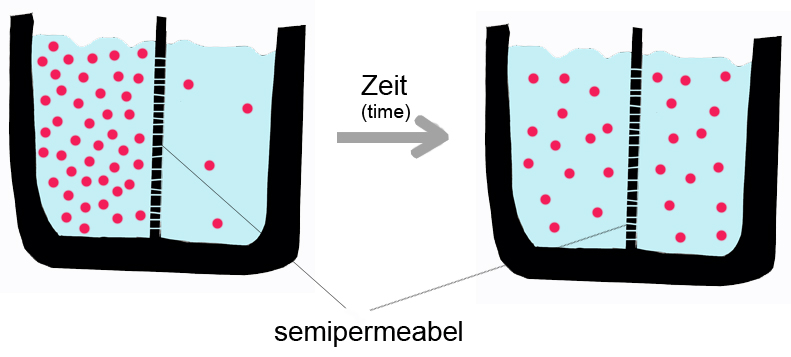 | The movement of molecules, other than water, from an area of greater concentration to lesser concentration |
Osmosis, 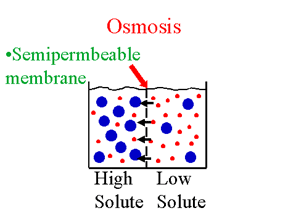 | The movement of water molecules from an area of greater concentration to lesser concentration |
| Solute | The which is added to the solvent; example, salt is a solute you add to the solvent water. This forms a salt water solution |
| Solution | Solvent + Solute |
| Solvent | Liquid that the solute gets added to; water is the universal solvent |
| Selectively Permeable | Selects what enters and leaves the cell |
| Equilibrium | When the concentration of the solute is the same throughout the solution |
Purpose of the cell wall,  | To provide support and protection for the cell |
| Cellulose | Complex polysaccharide found in cell wall; helps give it firmness and support |
Purpose of the cell membrane, 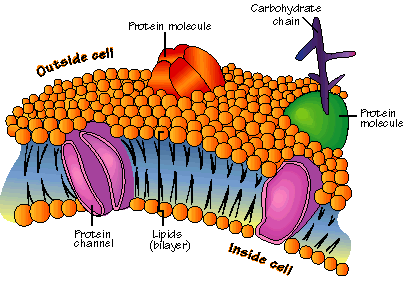 | It regulates what enters and leaves the cell; it also provides protection and support |
Structure of the cell membrane,  | It is composed of a doubled layered sheet called a lipid bilayer. The cell membrane is NOT one solid peice. Everything in life is made of smaller pieces and a membrane is no different. Compounds called proteins and phospholipids make up most of the cell membrane. The phospholipids make the basic bag. The proteins are found around the holes and help move molecules in and out of the cell.. |
What is the purpose of the lipid bilayer for the cell membrane?, 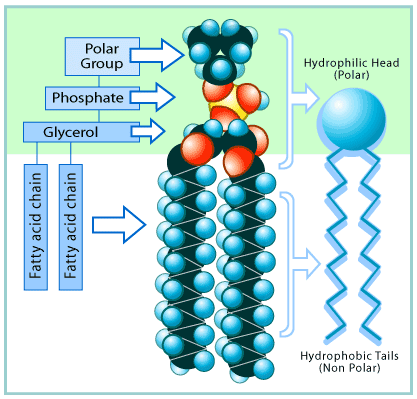 | It gives cell membranes a flexible structure that forms a storng barrier between the cell and its surroundings |
Define concentration in regard to diffusion and osmosis, 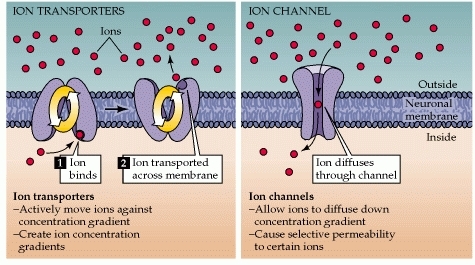 | Concentration is the measure of how much of a given substance there is mixed with another substance |
| Concentration of a chemical | Concentration of a chemical in a solution refers to how many of the chemical's molecules are sitting in a small volume of the solution. |
| Gradient | A gradient is a measurement of how much something changes as you move from one region to another. |
Concentration Gradient,  | It is a measurement of how the concentration of something changes from one place to another. |
Purpose of Proteins in the cell membrane,  | Specific proteins embedded in the cell membrane can act as molecular signals that allow cells to communicate with each other;Other proteins on the surface of the cell membrane serve as "markers" that identify a cell to other cells. |
| Purpose of Carbohydrates in the cell membrane | carbohydrates may hold adjoining cells together or act as sites where viruses or chemical messengers such as hormones can attach. |
| Purose of Cholesterol in the cell membrane | it helps maintain the integrity of these membranes, and plays a role in facilitating cell signaling-- meaning the ability of your cells to communicate with each other so you function as a human, rather than a pile of cells. |
| What is the concentation of a solution? | It is the mass of solute in a given volume of solution, or mass/volume |
| What is the concentration of 12grams of salt in 6 liters of water? | 12g/6L or 2g/L |
| Which solution is more concentrated: a soulution of 12g/3L or 12g/6L? | The 12g/3L is twice as concentrated as 12g/6L |
| T or F: Diffusion does not require the cell to use E | True |
| Isotonic Solution | The concentration of solutes is the same inside and outside the cell |
What happens to a plant cell in a hypertonic solution?, 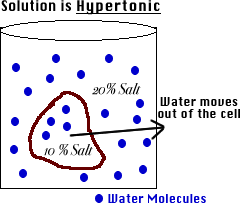 | It wilts; the water in the plant cell leaves the plant cell |
What happens to a blood cell in a hypertonic solution?,  | It loses water; dehydrates |
What happens to a plant cell in a hypotonic solution?,  | The water enters the cell and causes the cell to become larger; it builds up; this build up is called turgor pressure |
What happens to a blood cell in a hypotonic solution,  | It fills up and bursts; this bursting of a cell is called plasmoptysis |
| What structures protect plant and bacterial cells from potential damage resulting from osmotic pressure? | Cell wall; very tough. |
Facilitated Diffusion,  | It is the movement of specific molecules across cell membranes through protein channels. |
| What is the role of a protein channel in a cell membrane? | They make it easy for certain molecules, like glucose, to cross the membrane |
| Does facilitated diffusion require the cell to use E? | No |
| Active Transport | This is the process that moves materials from an area of lesser concentration to an area of greater concentration (opposite of diffusion) |
| How does active transport occur in the cell membrane? | There are secial proteins or pumps that are found on the membrane itself that carry on active transport |
Endocytosis, 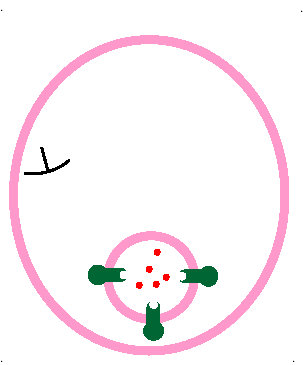 | The process of taking material into the cell by means of infoldings, or pockets, of the cell membrane. It always incolves changes in the shae of the cell membrane |
Exocytosis, 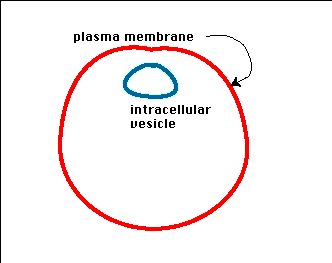 | This is how cells release large amounts of material from the cell; it always involves changes in the shape of the cell membrane |
Give two examples of endocytosis,  | Phagocytosis and Pincocytosis |
Phagocytosis,  | "Cell eating." It involves extensions of cytoplasm around a particle of food; food is engulfed |
Does phagocytosis involve E?,  | Yes as it is considered a form of active transport |
| What microorganism obtains its food by phagocytosis? | Amoeba |
Pincocytosis, 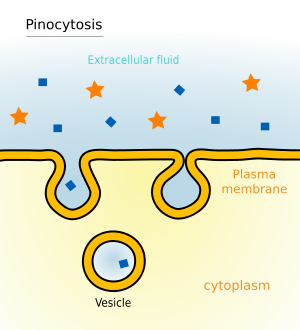 | Tiny pockets form along the cell membrane and pocket the liquid; this is also a form of active transport |
| Unicellular | One celled |
| Multicellular | Two or more celled |
| Cell specialization | Cells throughout an organism can develop in different ways to perform special tasks |
| Name the levels of organization | Cells; tissues; organs; organ system |
| Cell | Common denominator of all living organisms |
| Tissues | Group of similar cells that perform a special function |
| Organ | Many groups of tissues working together as an organ |
| Organ System | A group of organs working together of specialized tasks |
| Hydrophyllic | Molecules of the cell membrane that can bond with water; polar molecules; attract water to the cell membrane |
| Hydrophobic | Non polar moleucles; do not bond with water; repel water |
| Is the head end of a fatty acid hydrophobic or hydrophyllic? | Hydrophyllic |
| Is the tail end of a fatty acid hydrophobic or hydrophyllic? | Hydrophobic |
| T or F: All lipids are hydrophobic | True |
| Phospholipid bilayer | A type of lipid molecule occurring in a bilayer in biological membranes; a lipid with two fatty acids and a phosphate group attached to glycerol. |
| Fluid Mosaic Theory | ntists describe the organization of the phospholipids and proteins with the fluid mosaic model. That model shows that the phospholipids are in a shape like a head and a tail. The heads like water (hydrophilic) and the tails do not like water (hydrophobic). The tails bump up against each other and the heads are out facing the watery area surrounding the cell. The two layers of cells are called the bilayer. |
| Which process always involves the movement of materials from inside the cell to the outside of the cell? | Exocytosis |
| What are the examples of active transport? | Endocytosis (which includes phagocytosis and pinocytosis) and Exocytosis |
| Which processed do not require E? | Diffusion, osmosis and facilitated diffusion |
| Plasmoptysis | The breaking forth of protoplasm from a cell through a rupture of the cell membrane |
| Turgor Pressure | Turgor pressure or turgidity is the main pressure of the cell contents against the cell wall in plant cells and bacteria cells, determined by the water content of the vacuole, resulting from osmotic pressure |
| Osmotic Pressure | The pressure exerted by the flow of water through a semipermeable membrane separating two solutions with different concentrations of solute. |